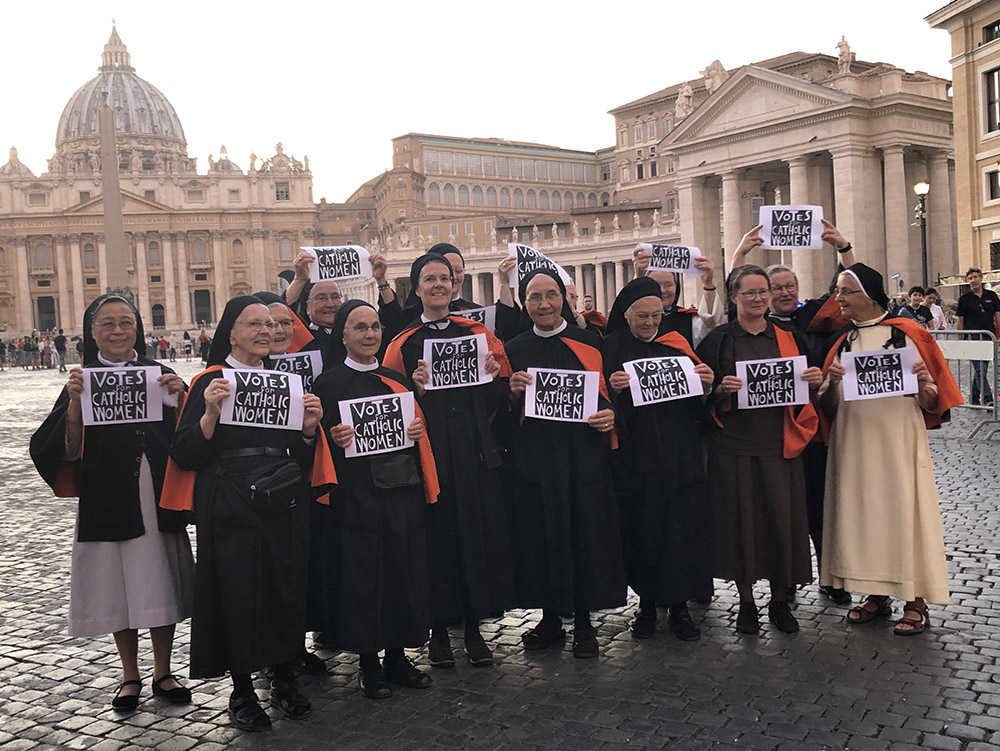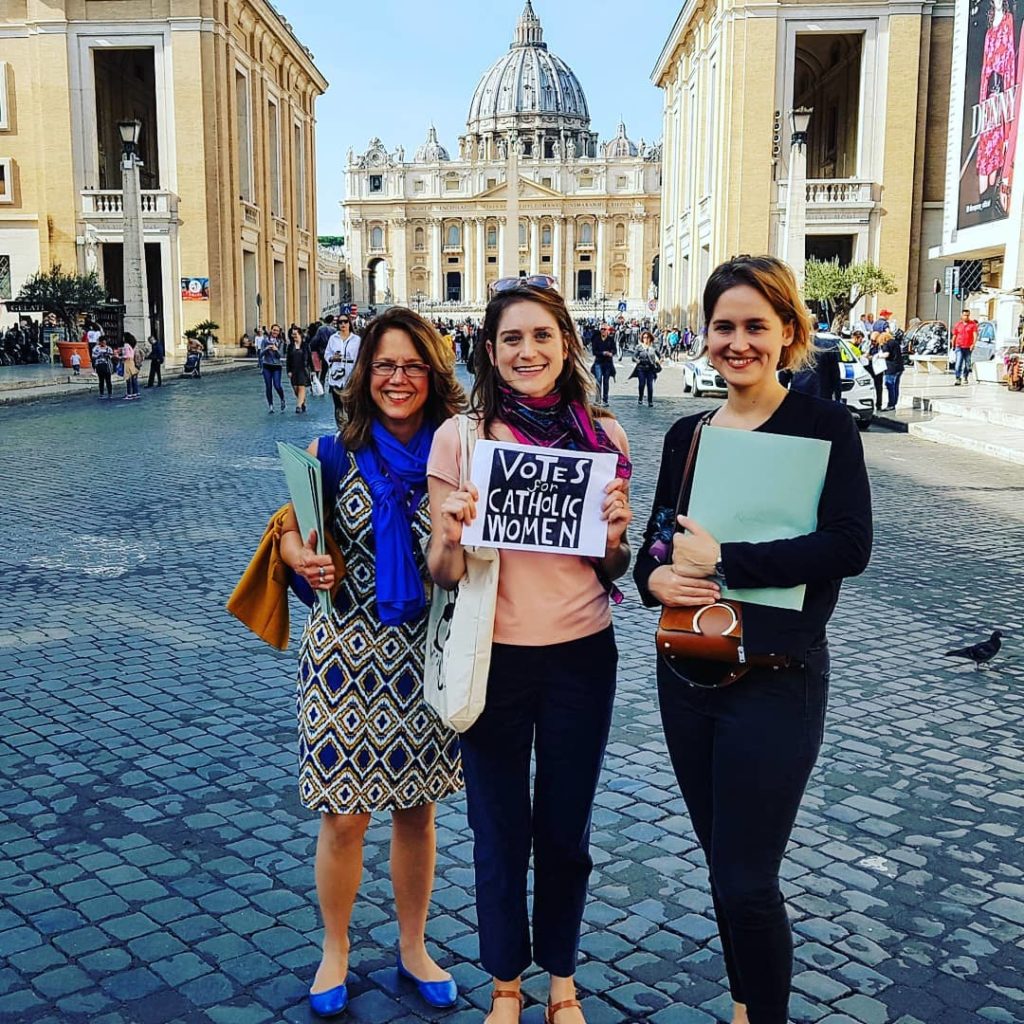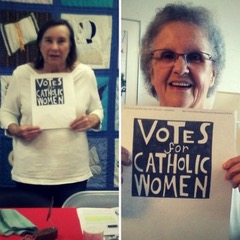The Pope’s Ear
Oh, our dear, impulsive Pope. I have long felt that if women could get Francis’ ear, we would see change. I wonder who got to him about women voting at the Synod.
Maybe he saw the photo of the German Benedictines from 2018, and was reminded of the scandal of sisters who lead religious orders being relegated to observer status when brothers who shared the same canonical status being allowed to vote in the 2015 Synod on the Family.

Maybe he looked at the pile of petitions delivered by Kate McElwee of WOC and Deb Rose of FutureChurch: almost 10,000 of the faithful urging that women be voting along with the many, many men at the Synod. Maybe he wondered how they got the Votes for Catholic Women sign to decorate the doors of the Congregation for the Doctrine of the Faith. In case you want to know a lot more about the synods of the last ten years, Sebastian Gomes recounts the history in exquisite detail in America, and even links to the petition.
People are still signing.

Maybe it was Sister Nathalie Becquart, Undersecretary of the Synod with the right to vote, or Sister Filo Hirota on the Synod preparatory commission, or lay woman Elmice Cuda, Secretary of the Pontifical Commission for Latin America, or any one of the other women Francis has gotten to know because they serve in important administrative jobs. He’s been impressed with women in this category, and remember, sisters and nuns are lay women. Maybe Sister Nathalie said she didn’t want to be the only woman voting.
Pope Francis went way beyond what I expected with his decision to involve laity. It makes sense; thousands of people around the world (mostly lay, from what we can tell) were involved in the Synod process. Including this small number (70 lay voters, plus 5 nuns; women about 10% of the total) to deliberate about the process going forward is an acknowledgement of the caring and contributions of all those who participated.
Of course, it’s Francis’s brand of theology on the fly. On impulse, or so it seems to me. There’s a lot of fancy language floating around about the proper “discernment” of people in various roles: laity at one level, bishops at another, pope at the end. Gomes has a dose in America. But the reality on the ground threatens this hierarchy. The experience of synodality, which is the process of sharing all this discernment, is undercut if what has been discerned is then ignored.
I’m not suggesting that that I expect the consensus to be ignored. I actually expect some progress on deacons in October 2024, a compromise measure that will satisfy the narrow middle and unsettle both those who want full equality in ministry and those who want a totally male hierarchy. And I suppose I will find myself among the large group on the boundary between that narrow middle and the full equality crowd. Predictions are dangerous, however.
On the other hand, it is so hard for me to understand how some can cling to the totally male fringe. How unhappy they must be with the rest of their lives! Or maybe they have no lives outside of the church and its restrictive anthropology, as reading the Nordic bishops’ “Pastoral Letter on Human Sexuality” suggests. Bobby Nichols and Robert Shine for New Ways Ministry summarize: “However, the letter also heavily endorses gender complementarianism, or the idea of a strict sex binary in which male/female complementarity are key, and rejects developments in understandings of sexuality and gender, referring to them as being ‘in flux’ and ‘passing theories.’” They link to the whole document if you require more.
The Pope himself may be struggling to leave the same male fringe. It’s what I call his Fratelli Tutti problem. I don’t think he could have uttered Sisters All when he wrote that letter. It is so inspiring in so many, but not all, ways. Maybe he understands that what he feels so deeply about his brothers excludes not only women but the many people, especially many young people, who identify as LGBTQ+ or sympathize with them. Every document coming out of the synod process affirms that the people of God want an inclusive “social friendship” with no one at the margins. The image – Fratelli – leaves many out, no matter what else is said in the document.
And Francis certainly understands images. Consult Griffin Oleynick’s interview with filmmaker Gianfranco Rosi in Commonweal. Rosi’s documentary In Viaggio includes footage from Francis’s whole papacy; the images in the trailer are among the most memorable. The oddly prescient Rosi says: “Francis is also a revolutionary. He’s changing a lot of things inside the Church, trying to open it up. He’s the first pope to talk openly about the possibility of civil unions for gay people. He never speaks about abortion in an accusatory, aggressive, or judgmental way. He comforts the women who have gone through that painful process.” I would be interested in seeing any footage he found of that. The film is available for a fee on Amazon Prime, which I try to avoid.
Revolutionary may not be an image Francis himself would choose; even Robert Mickens in La Croix International rejects it. His conclusion is grumpy: “It’s not so much a tidal wave, as it is a few ripples in waters that are still too stale and stagnant. But, as they say, it’s a start.”
When I reread the petition and I realize how much more beyond it this action is, I am inclined to be grateful to Francis for coming this far, no matter how much control he keeps of the process. I’m going to hope that whoever has his ear keeps control of that access.


2 Responses
Yes!! His ears! Thanks, Regina.
Let us pray that the “few ripples of water” become a river of clean water that washes away 2000 years of “stale and stagnant” patriarchy.